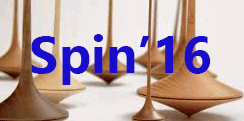Speaker
Description
The STAR experiment at RHIC has provided significant contributions to our understanding of the structure of the proton. The STAR experiment is well equipped to measure W± → e± +ν in √s = 510 GeV longitudinally polarized p + p collisions at mid rapidity (|η| < 1). The longitudinal single spin asymmetry in W production, AL, measured as a function of decay positron (electron) pseudo-rapidity η for W+(W−) is sensitive to the individual helicity polarizations of u and ¯d (d and ¯u) quarks. Due to maximal violation of parity during the production, W bosons couple to left-handed quarks and right-handed anti quarks and hence offer direct probes of their respective helicity distributions in the nucleon. The published STAR AL results (combination of 2011 and 2012 data) have been used by several theoretical analyses suggesting a significant impact in constraining the helicity distributions of ¯u, and ¯d quarks. In 2013 STAR collected a dataset at √s = 510 GeV with a total integrated luminosity of ∼300 pb−1 with an average beam polarization of ∼54%, a figure of merit three times larger than the dataset used by previous analyses. We will report the status of the analysis of the STAR 2013 W AL along with the future plans for final W AL results by combining both STAR 2012 and 2013 data of total integrated luminosity of about ∼400 pb−1.
W cross section ratio (W+/W−) measurements at STAR are sensitive to unpolarized u, d, ¯u, and ¯d quark distributions. At these kinematics, STAR is able to measure the quark distributions near Bjorken-x values of 0.1 at a Q2 scale set by the W mass. The increased statistics from the STAR 2013 data collection, will lead to a higher precision measurement of the W+/W− cross section ratio. An update of the W cross section ratio analysis from the STAR 2011, 2012 and 2013 runs is presented.
